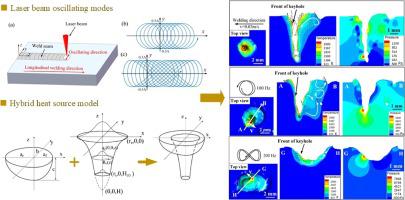Optics & Laser Technology ( IF 4.6 ) Pub Date : 2020-08-20 , DOI: 10.1016/j.optlastec.2020.106540 Wenchao Ke , Xianzheng Bu , J.P. Oliveira , WeiGang Xu , Zhimin Wang , Zhi Zeng

|
This paper presents a numerical framework of keyhole-induced porosity formation and methods to suppress porosity in laser beam oscillating welding. Circular and infinity oscillating paths with amplitude of 2 mm and frequencies of 100 Hz and 200 Hz were used. A numerical model for multiple phases, including solid metal, liquid metal and shielding gas is presented using the commercial software FLUENT. An adaptive rotated Gaussian volumetric heat source was developed for analysis of the heat input and temperature distribution during laser oscillating welding. The mechanism of porosity formation caused by keyhole collapse is studied by means of numerical analysis and experiments, and compared to conventional laser welding without oscillation. The numerical simulations were in good agreement with the experimental results. It can be concluded that upon the use of oscillation during welding, porosity decreased and was fully inhibited when using infinity-oscillating path with a frequency of 200 Hz. The developed multi-physics model aids in understanding the dynamics characteristics and keyhole-induced porosity formation during laser beam oscillating welding of 5A06 aluminum alloy.
中文翻译:

5A06铝合金激光振荡焊接中小孔致孔形成的建模与数值研究
本文提出了一个小孔引起的气孔形成的数值框架和抑制激光振荡焊接中气孔的方法。使用振幅为2 mm且频率为100 Hz和200 Hz的圆形和无穷大振荡路径。使用商业软件FLUENT给出了包括固态金属,液态金属和保护气体在内的多个相的数值模型。开发了一种自适应旋转高斯体积热源,用于分析激光振荡焊接期间的热量输入和温度分布。通过数值分析和实验研究了由锁孔塌陷引起的气孔形成机理,并与无振荡的常规激光焊接进行了比较。数值模拟与实验结果吻合良好。可以得出结论,在使用焊接过程中的振荡时,当使用频率为200 Hz的无穷大振荡路径时,孔隙率降低并被完全抑制。建立的多物理场模型有助于理解5A06铝合金的激光振荡焊接过程中的动力学特性和小孔引起的气孔形成。











































 京公网安备 11010802027423号
京公网安备 11010802027423号